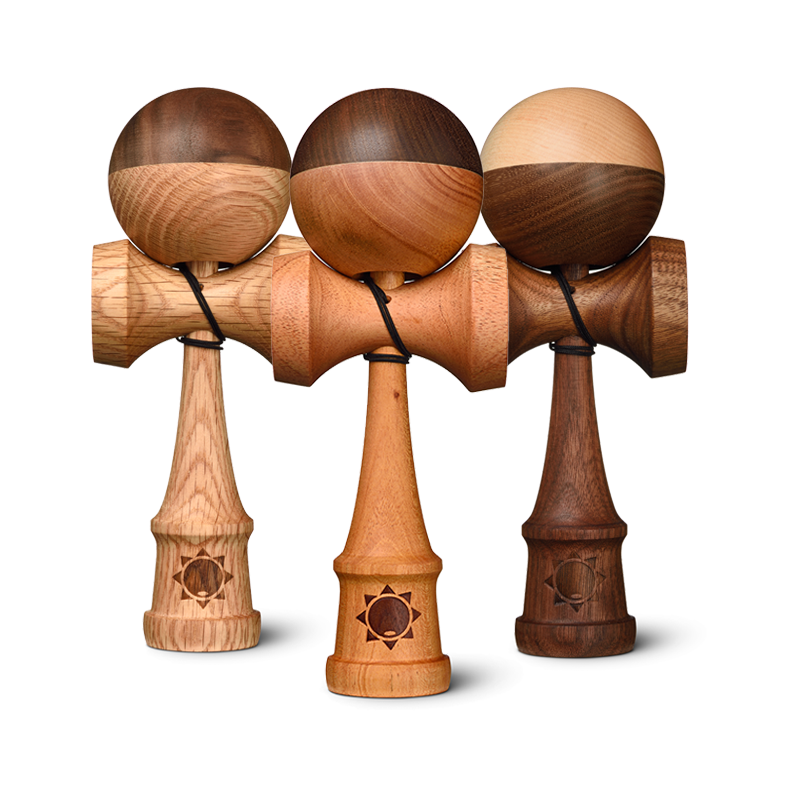

Do you ever wonder why some kendamas are made of different kind of woods? What if a kendama felt smooth or rough to the touch? What if the weight of a kendama changed the way you felt about it?
Knowing all of the details behind kendama styles might influence your decision on which kendama to play with or purchase! Let's talk wood.
Ash wood makes for an incredible kendama. The premium quality of the wood leaves for both interesting grain patterns and stellar play. This is a favorite for everyone. Ash is love at first sight for many players. It's like playing with art.
| Cost: | Premium |
| Density: | Average density |
| Durability: | Good durability |
| Feel: | Smooth, but wide grain |
| Performace: | Great performance |
| Weight: | Average weight |
Kendamas that use Ash wood:
Beech wood is the most popular type of wood used in kendama. The reasons are simple: it is inexpensive, durable, and is a fair weight. These are fantastic kendamas for a beginner, due to durability and cost. It's everything right in a kendama.
| Cost: | Inexpensive |
| Density: | Average density |
| Durability: | Average durability |
| Feel: | Slightly rough to the touch |
| Performace: | Good performance |
| Weight: | Average weight |
Kendamas that use Beech wood:
Cherry wood is a very light wood used in kendamas, and is suitable for those who enjoy a softer wood. It has a slightly pinkish look and is enjoyable to hold. It is also generally less expensive than other kendamas. A light kendama like the cherry is very easy to juggle and balance.
| Cost: | Fairly Inexpensive |
| Density: | Not very dense |
| Durability: | Less durable than beech |
| Feel: | Very soft |
| Performace: | Good performance |
| Weight: | Light weight |
Oak wood is similar to beech, and is generally all around fantastic. It has a very strong cross grain and strong grain in general. It is featured in our Flow Kendama line and plays incredibly well.
| Cost: | Affordable |
| Density: | Average density |
| Durability: | Average durability |
| Feel: | Rough to the touch (you can feel the grain!) |
| Performace: | Great performance |
| Weight: | Average weight |
Kendamas that use Oak wood:
Mahogany is an incredible unique and beautiful wood. Boasting a gorgeous orange hue, Mahogany is perfect if you're looking for a cool kendama with style. On top of good looks, it also plays fantastically.
| Cost: | Premium |
| Density: | Slightly more dense |
| Durability: | Good durability |
| Feel: | Smooth to the touch |
| Performace: | Great performance |
| Weight: | Average weight |
Kendamas that use Mahogany wood:
Maple is another incredibly popular wood used in kendama. Primarily for durability, maple is also used for its clean looks. Maple also boasts a wonderful noise when making contact on a kendama. It's an absolute favorite of the kendama community and I'd recommend at least one maple kendama in your collection.
| Cost: | Inexpensive/Affordable |
| Density: | Slightly more dense |
| Durability: | Great durability |
| Feel: | Smooth to the touch |
| Performace: | Great performance |
| Weight: | Light/Average weight |
Kendamas that use Maple wood:
Walnut is also popular, although a bit less than maple. Walnut is a perfect wood to use in laminations (or splits, such as stripes) because of its strong contrast with lighter woods. This dark wood tends to be light and have beautiful grain.
| Cost: | Affordable |
| Density: | Slightly less dense |
| Durability: | Okay durability (slightly brittle, beware of concrete!) |
| Feel: | Fairly smooth to the touch |
| Performace: | Good performance |
| Weight: | Light weight |
Kendamas that use Walnut wood:
It is good to know what type of wood you're looking for before making a purchase. Ultimately, it comes down to your personal style. Don't be afraid to try new kendamas, despite being a size, weight, or style that you're not used to playing. You might make a new friend!